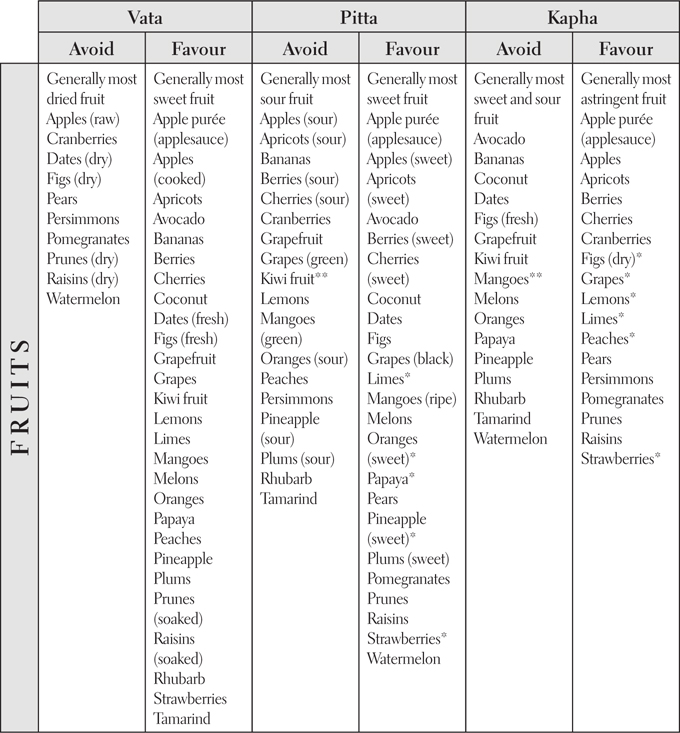
Finding time to make any level of change is not easy. I know this first hand, as someone who feels lucky when I find myself with a (rare) couple of free hours in the evening, once essential life tasks are ticked off, children fed, enjoyed and put to bed and all work projects completed. So, I want to offer a realistic approach. Rather than asking that you take seven days (which is nigh-on impossible unless you take a complete holiday, and even then, if family or work commitments sneak in, you’ll be forced to cut corners), I have built this immersion into three dedicated, restful days away from work and heavy responsibilities (perhaps over a long weekend) and I then adjust the plan to allow you to go back to work, but continue with your immersion at a realistic pace that will slot in and around your existing routine. Being able to take this time to yourself, and allow yourself true peace, rest and relaxation, will mean that your body is more powerfully supported and you’ll achieve faster results.
This immersion is designed to work at any time of year alongside your general Ayurvedic diet (although doing it in spring does give you the mental edge, as we’re wired to want a fresh start in spring), and is the perfect introduction for Ayurveda virgins, but also a great top-up – to boost immunity and energy or to cleanse the system after a period of not eating to plan.
Doing this immersion at home is also uniquely supportive of Ayurveda as you’re disturbing as little of your life and routine as possible. Your home environment is naturally nurturing – it’s familiar and safe, and embarking upon a lifestyle change at home (rather than in an expensive spa, or on a retreat across the other side of the world) gives you a real advantage. It means you don’t have the classic ‘Catch-22’ of going away to make a ‘fresh start’ which falls by the wayside the moment you return home to ‘real life’. While I first learned about Ayurveda on my retreat in the Maldives, it was some time before I was able to introduce Ayurveda properly into my home life. I was on a learning journey, and my interest was piqued, but until I sat down and started thinking about how to shop, cook and live it in the UK, it wasn’t a real part of my life. This is why I always condone changes that start at home – you’ll get a true insight into a new way of doing things that realistically fits around your family and existing environment.
The main focus of this plan is to shift stubborn ama. As we’ve discovered, ama is often the thing that prevents us from losing weight – this build-up of toxins and waste material is hard to cleanse. It requires a committed approach, and strategic use of certain herbs and spices, which all enable the body to steadily rid itself of this deeply stored stagnant matter. There are some ‘best practice’ options; if you can commit to doing them, please do – you’ll feel so much better for it – or ‘gentler’ options, which will be less powerful, but still effective. Lest you start to panic, I can also assure you that nothing is aggressive.
Ayurveda is so beautifully in tune with life and the body that all change is seen as a result of organic rebalancing. We may be in possession of ‘excesses’ which need to be purged, but Ayurveda knows that an overly strict or spartan approach can cause further deficiencies. In order to balance, without taking too much away, or putting too much strain on the system, a specific blend of whole foods, herbs and spices is recommended. The good news is you never go hungry – it is a food-based cleanse that will nourish, uplift, soothe and calm, while also working to kickstart purification and cleansing of the digestive system (but without horrible side effects).
I know many people are advocates for all-raw or juice-only cleanses, and thankfully, Ayurveda does not endorse this approach. If you are attempting to cleanse your body it will need to be amply supported, and an all-raw diet is just too taxing to your digestion (and a bad idea in cold weather as it really increases Vata), while a juice-only diet is just not satiating enough (and hunger is the ultimate enemy of diet success, along with being the main cause of serious grumpiness on my part!). Being hungry also causes acute anxiety; we’re conditioned to panic when food isn’t available, and this is why crash dieting is doomed to fail. Feeling anxious, grumpy, even angry because you’re hungry is not conducive to a mind/body cleanse. We want to discover balance and find peace – not spend a week dreaming about chocolate bars and big bowls of pasta.
As I found during my first immersion diet, many years ago now, I could still eat, and eat well, as long as food was appropriate and easily digested. I felt strong and vital, slept well, my skin brightened and, yes, I lost eight pounds in a week. My immersion was also amply supported by Ayurvedic treatments which focused on rebalancing my chakras, and if it’s possible for you to enjoy an Ayurvedic treatment from a reputable practitioner during your immersion, I’d wholeheartedly recommend it. Again, the power of treating the outside along with the inside is always more powerful and promotes changes that are far more likely to ‘stick’.
Alongside diet advice, there are some strong lifestyle and wellbeing suggestions. What I find most impressive (and intuitive) about Ayurveda is the understanding that, even when we’re eating good food, we’re not able to get from it what we need if our frame of mind or body isn’t in the right place. If your stomach is in figurative knots, it’s not going to do the best job of digesting what goes into it. Ayurveda understands the strain that stress, anxiety, fear, grief and so on can have upon the digestive system, and though we’re certainly helping ourselves when we put in wholly nourishing, balanced food, we can’t expect to be truly balanced until we put all of the emotional stresses and strains to rest too.
This plan, therefore, is designed to get us to a place where every part of our mind, body and gut is in optimal balance, and this is the place from where we can move forward, stronger and more vitally than would’ve been possible if we took a surface-only approach.
1. I’ve found that it’s always helpful to say things out loud – to yourself, and to those around you. If you have decided to embark upon this Ayurvedic immersion, you should tell your family and friends. It will give you permission to take the time and space you’ll need to do it properly, and also cement your intention to make this change. Being supported by your partner or children can be a key part of this process – you may even find that a friend would like to try it alongside you. This is, however, a necessarily solitary exercise . . .
2. . . . so make time to be alone, peaceful and reflective. Including daily yoga into your routine is a great way to make this time. If yoga is entirely new to you, try to make the time for a class (if you want to stay at home, www.balanceplan.co.uk has wonderful quick, but effective yoga sessions to guide you in your practice). Journaling is another valid way of making ‘me’ time. Schedule 15 minutes into your day, the week before you begin, and write down your thoughts and feelings as they occur to you. It will help prepare your mind for the change it’s about to encounter too.
3. Get as much rest as possible. Try to get your sleeping schedule on track, even if it means lights out at the same time every night. If you are always fidgety in bed and take an age to wind down, try an ancient Ayurvedic trick – deeply massage warm sesame oil into the soles of your feet before getting into bed. It will warm the body up and ease tension as you sleep.
4. Try to eat in line with your dosha for the days leading up to your immersion. It will start to bolster your body before you’ve even begun. It’s also wise to cut down on the things you know aren’t helping you – nicotine, caffeine, alcohol, refined foods and excess sugar.
Choose three consecutive quiet days, when you have few commitments and you are not working. Surround yourself with things that encourage peace of mind and a sense of wellbeing: your favourite classical music, a cherished novel, some new watercolour paints to experiment with. This is your time – an Ayurvedic holiday of sorts. Try to start each day with optimism and joyful anticipation.
1. After waking, drink a glass of hot water (you can add a slice of fresh ginger or a squeeze of lime; or add a cinnamon stick or a crushed cardamom pod, then strain) to hydrate and encourage cleansing.
2. Take time to massage your entire body with a doshaspecific oil (see page 109). Sesame oil can be used by all three doshas – its warming, nurturing properties are ideal for your body when it’s going through a period of cleansing. For a step-by-step guide to Abhanga massage, be sure to visit www.balanceplan.co.uk.
3. Your first meal should be a nurturing porridge (see recipes on pages 173–6 for different porridge options, and choose the version that best supports your dosha). Ayurvedic puritans often make porridge with basmati rice (which is quite tasty) or dhal (which I find a bit strange for my palate), and I like to vary the grains I use to keep things interesting. Chia seeds, oats, quinoa and millet are all good, and I offer a variety in the recipe section.
4. Your lunch should be a balancing, cleansing dish that I call my Soul-Soothing Stew for its easy nourishing properties (see recipe on pages 194–5). Based on kitchari – the traditional healing Ayurvedic dish – it is designed to be eaten at times when the body is weak, needs repair, needs to detox and cannot be taxed. It is easily digested, tasty and filling. As I also believe that variety is important in terms of nourishing the body, I suggest some additional touches and flourishes to add interest to this dish if you are going to be on the immersion for several days.
5. Take an hour in the middle of the day to do some yoga.
6. If the weather is conducive, take a leisurely stroll outside – ideal in spring, summer or early autumn, when the weather is still mild. Take your time, breathe deeply and pay attention to your natural environment. If it’s winter, bright clear days are also lovely for a walk, but I wouldn’t recommend a stroll in very wet or bitterly windy weather – your body needs support, not a meteorological onslaught! If the weather is unwelcoming, it is still important to get some fresh air, so throw open the windows of your home and let the fresh wind rip through for a few minutes; just ensure you’re wrapped up. Do this every few hours to prevent the air in your home getting stagnant (especially important if you use central heating).
7. Dinner should be another small bowl of Soul-Soothing Stew (see pages 194–5).
8. Between 30 minutes and an hour before you plan to fall asleep, take two Triphala tablets with a glass of warm water. This will help the body cleanse itself further overnight, and also help combat potential constipation (although due to the natural whole foods you’ll be eating it would very unusual to experience this on the immersion diet).
9. Dim the lights, turn off all electrical gadgets and choose a book for bedtime. Bathing at night isn’t traditionally advised in Ayurveda, but I find nothing encourages sleep more effectively. Burn a favourite natural-wax, non-smoking candle as you run a bath. Add a big scoop of magnesium salts to the bath, let them dissolve, then sink into the water. I like to fill the bath just high enough to allow me to lie flat within it, water covering my ears and body, my nose and mouth just out of the water. The feeling of submerging the head is incomparably relaxing and great if you’ve felt slightly headachy today.
10. Massage your specific oil all over your body, pull on some comfortable cotton pyjamas and get into bed to read for 30 minutes, before turning the light out and going to sleep.
11. Keep a glass of room-temperature water by your bed as you may feel thirsty through the night as your body begins to purge excess salts and toxins.
1. After waking, drink a glass of hot water (you can add a slice of fresh ginger or a squeeze of lime; or add a cinnamon stick or a crushed cardamom pod, then strain).
2. Half an hour after your water, enjoy a bowl of doshaspecific porridge, chosen from the recipe section.
3. Attend a morning yoga session – use a DVD, an online tutorial, or, if you have a nice local class that is within easy reach, find the time to attend today.
4. Lunch can be Soul-Soothing Stew, Love Broth or Red Lentil and Coconut Soup (see recipes on pages 194–5 and 199–202).
5. If it is summer and the weather is overly hot, enjoy a post-lunch siesta in a room with open windows. If it is winter, curl up under a warm blanket and rest for an hour, letting thoughts come into your mind freely, which you then acknowledge and release without focusing on them. Focus instead on your breathing and the feeling of release within your body.
6. Once you’re rested, choose a favourite activity: some non-strenuous gardening, painting, reading, singing, listening to music. Concentrate on the task at hand, enjoying the focus you give to it, and feel your breath slowing and steadying as you continue to relax.
7. Take time to prepare a nourishing supper – my Soul-Soothing Stew will continue to nourish you now. Feel free to add some extra, different vegetables that will also balance your dosha – courgette/zucchini and sweet potatoes are great for Vata and Pitta types, add cauliflower or beetroot for Kapha. You can also alter spicing to add interest – adding ground ginger for both Vata and Kapha, and coconut flakes or fresh coriander/cilantro leaves for Pitta.
8. Eat slowly, lovingly, without distraction.
9. Between 30 minutes and an hour before you plan to fall asleep, take two Triphala tablets with a glass of warm water. Again, this will help the body cleanse itself further overnight and also dispel excess gas and soothe the stomach.
10. Dim the lights, turn off all electrical gadgets and ready your book for bedtime. Take another mineralizing bath – add a big scoop of magnesium salts to hot water, let them dissolve, then sink into the bath.
11. Massage your specific oil all over your body, pull on some comfortable cotton pyjamas and get into bed to read for 30 minutes, before turning the light out and going to sleep.
12. Keep a glass of room-temperature water by your bed as you may feel thirsty through the night as your body purges excess salts and toxins.
1. This is the last day of your immersion diet. Wake up with purpose, reflectively and meaningfully and consider all the things you are thankful for and that help put a smile on your face.
2. Drink a glass of hot water (you can add a slice of fresh ginger or a squeeze of lime; or add a cinnamon stick or a crushed cardamom pod, then strain).
3. Wait 30 minutes, then enjoy a bowl of nourishing doshaspecific porridge.
4. Curl up with your book and spend the morning reading, or if you prefer, journaling – writing down the thoughts you have as and when they occur to you. If any thoughts are negative or worrisome, think about what you may be able to do to resolve them throughout the course of the next week. Write down your resolutions and make a plan of action, then put it away in a drawer, ready to take out tomorrow, when your immersion will be over and you will feel even more energized.
5. Enjoy a steamed green vegetable salad for lunch. Choose from the recipes below according to your dosha type, and use organic vegetables. This is my Ayurvedic take on an alkalizing raw green juice, but it doesn’t tax the body. Juicing is not recommended for Vata types, who need to eat warming, nourishing meals to keep their systems in check (juice fasts will make you gassy, irritable and uncomfortable). Pitta types too, because of their strong digestive fire, needs to eat regular proper meals to sustain energy levels, not cut down to a few juices a day (this will do nothing to keep agni fired up either). Kapha types may be the only exception here, in that these types do well to fast occasionally, and will feel far more energized than the other doshas if they do.
• For Vata: Prepare (wash, peel, trim) one small courgette/zucchini, four spears of asparagus, one small leek and a small cucumber (English ‘hothouse’ cucumbers are much sweeter than ridge varieties). Chop into 2.5cm/1in-long pieces, and cook all but the cucumber through in a pan with some good olive oil and a pinch of Himalayan rock salt, plus parsley, poppy seeds, ground coriander and garlic, until all the vegetables begin to tenderize. Once tender, add the cucumber to warm through. Drizzle with sesame or olive oil, add a squeeze of lime and eat slowly, chewing every mouthful thoroughly.
• For Pitta: Prepare (wash, peel, trim) one small courgette/zucchini, four spears of asparagus, one small leek, a handful of broccoli florets and a small cucumber. Chop into 2.5cm/1in-long pieces, and cook all but the cucumber through in a pan with some good olive oil and a pinch of Himalayan rock salt, plus ground coriander, fresh ginger and fresh basil, until all the vegetables begin to tenderize. Once tender, add the cucumber to warm through. Drizzle with walnut or olive oil, add a squeeze of lime and eat slowly, chewing every mouthful thoroughly.
• For Kapha: Prepare (wash, peel, trim) one small artichoke heart, four spears of asparagus, one small leek, a handful of broccoli florets, and a handful of celery. Chop into 2.5cm/1in-long pieces, and cook through in a pan with some sunflower oil and a pinch of cayenne, plus ground ginger, fresh grated garlic and some poppy seeds, until all the vegetables begin to tenderize. Once tender, add a squeeze of lime and eat slowly, chewing every mouthful thoroughly.
6. Have a rest after lunch.
7. Attend an afternoon yoga class, or follow a DVD or an online tutorial.
8. Dinner can be Soul-Soothing Stew, Love Broth or Red Lentil and Coconut Soup (see recipes on pages 194–5 and 199–202).
9. Eat slowly, lovingly, without distraction.
10. Between 30 minutes and an hour before you plan to fall asleep, take two Triphala tablets with a glass of warm water. This will help the body cleanse itself further overnight and also dispel excess gas and soothe the stomach.
11. Dim the lights, turn off all electrical gadgets and ready your book for bedtime. Take another mineralizing bath – adding a big scoop of magnesium salts to hot water, let them dissolve, then sink into it.
12. Massage your specific oil all over your body, pull on some comfortable cotton pyjamas and get into bed to read for 30 minutes before turning lights out and going to sleep.
13. Keep a glass of room-temperature water by your bed as you may feel thirsty through the night as your body begins to purge excess salts and toxins.
For the rest of the week begin every day with hot water and some ginger, lime or cardamom. Continue to drink herbal teas and filtered water. Eat Ayurvedically as much as possible – the recipes at the back of this book will really help you.
Drinks
You can drink any variety of herbal teas throughout the day – tulsi tea is a great tonic, elevating and balancing the mind and mood alongside supporting your cleansing system. Fennel, nettle, aniseed, sage and ginger tea are all good too. Check the Taste Table (on pages 153–64) to find out which teas best support your dosha. All the water you drink during the immersion should be warm (boil the kettle and get into the habit of using it to top up your filtered water with hot water throughout the course of the day).
Snacks
If at any point you feel hungry, try a cup of tea. If you are still hungry after the tea, prepare a light snack. Make it unprocessed whole food and dosha-specific – seasonal fruits, raw unsalted and unprocessed nuts, lightly steamed seasonal vegetables, or even a small extra helping of Soul-Soothing Stew if you are feeling particularly hungry. You could also make up a batch of Love Broth, a healing, nourishing soup that can be enjoyed in place of cups of tea if you get tea’d out! Do try not to eat for eating’s sake, though – allowing the body to digest the food you eat for breakfast, lunch and dinner is important, and will be difficult if you snack all day. Likewise, don’t feel you need to go hungry if you’re getting genuine pangs. Be true to what you need and listen to your body – a key part of achieving body balance! If you’re having trouble determining whether your hunger is ‘real’ or imagined, schedule a walk or one of the wellbeing suggestions below into the spaces between meals. If you’re like me, you may well find that all you need for your hunger to dissipate is a bit of distraction.
Wellbeing
As this is your time, enjoy a few pampering Ayurvedic rituals such as the one opposite, all of which are aimed at aligning your chakras and achieving a sense of unity between body and mind.
If you immerse yourself for three days, the main thing to try and hang onto is the sense of control and calm you’ll gain from this focused ‘you’ time. It’s so easy to get sucked back into the drama and pressure of ‘real life’ – and it goes without saying that real life will go on, with or without you – but there must be a way for you to assimilate all you’ve learned and experienced
Balancing the Chakras
Denise Leicester, founder of Ila Beauty
Music and massage are subtle ways to touch the most sensitive and vulnerable yet powerful parts of ourselves – the chakras. Bathing in a Himalayan salt bath with oils such as vetiver, spikenard, patchouli and a little ginger is very nurturing to the earth (muladhara) and water chakras (swadhisthana).
Chakras respond to healing music, especially certain mantras that have vibrational healing for the chakras.
Conscious massage is a beautiful way to nourish the heart chakra (anahata) as the skin and the hands are the organs that are connected to the heart. Oils such as jasmine, rose and sandalwood have a beautiful resonance with the heart. Acknowledging each part of the body with love and gratitude as you massage is wonderful.
Foot baths and reflexology are very healing to the solar plexus (manipura) chakra as the feet are organs connected to the solar plexus. The soul (ajna) and crown (sahasara) chakras are balanced through meditation and stillness. into that daily routine. The main thing that will help you is the maintenance of a balancing, supporting, stress-relieving diet – this will be your food foundation, a strong helping hand to keep you healthy, even when life is more taxing than normal.
Acquaint yourself with the recipes in this book, and the Taste Table, and whenever possible try to choose a meal that will help support you and balance your dosha for at least a full week after your immersion. By eating Ayurvedically you’ll continue to carry the torch lit during your immersion, and fan that digestive fire, which will continue to grow and flourish if you carry on taking in the correct food. By eating this way, as often as you can, you’ll steadily find your body moving closer to its centre, and closer to its natural, balanced, healthy state.
Food is miraculous, but it is not the whole picture. In the days after your immersion, it’s also important to continue to strive for peace of mind and clarity of purpose. You made the time to immerse yourself, you did something quite wonderful, something beautiful for your body – don’t let it slip away. Every day after your immersion do a bit of yoga, meditate, practise mindfulness, carry out an Ayurvedic massage . . . or continue in an even more committed way by seeking out a local Ayurvedic centre or group, and begin to incorporate the seasonal wisdom of this incredible, ancient science into the circle of people you share your life with. Cooking for other Ayurveda lovers is really satisfying – a great learning curve and fantastic way to pick up new recipes yourself too. This book is just the beginning of what could become a naturally balanced way of life, for life.
The very kind Ayurvedic Institute, run by world-renowned Ayurvedic physician Vasant Lad, BAMS, MASc, has here allowed me to reproduce their incomparably thorough Food Guidelines for Constitutional Types (which I’ve nicknamed the Taste Table). Nobody has ever done it better, and it’s been a source of constant reference for me ever since I began my Ayurvedic journey five years ago, thanks to its continual updating. I thank them profusely for their generosity.
Note from the Institute: Guidelines provided in this table are general. Specific adjustments for individual requirements may need to be made, e.g. food allergies, strength of agni, season of the year and degree of dosha predominance or aggravation.
Key
* okay in moderation
** okay rarely


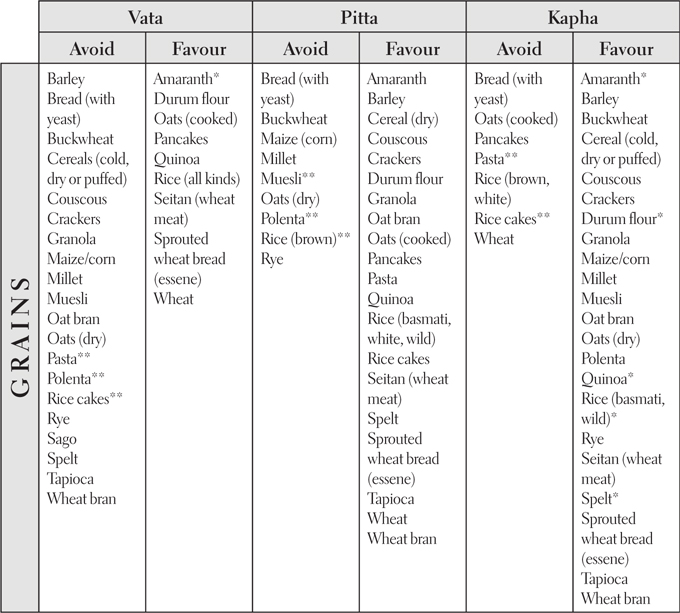
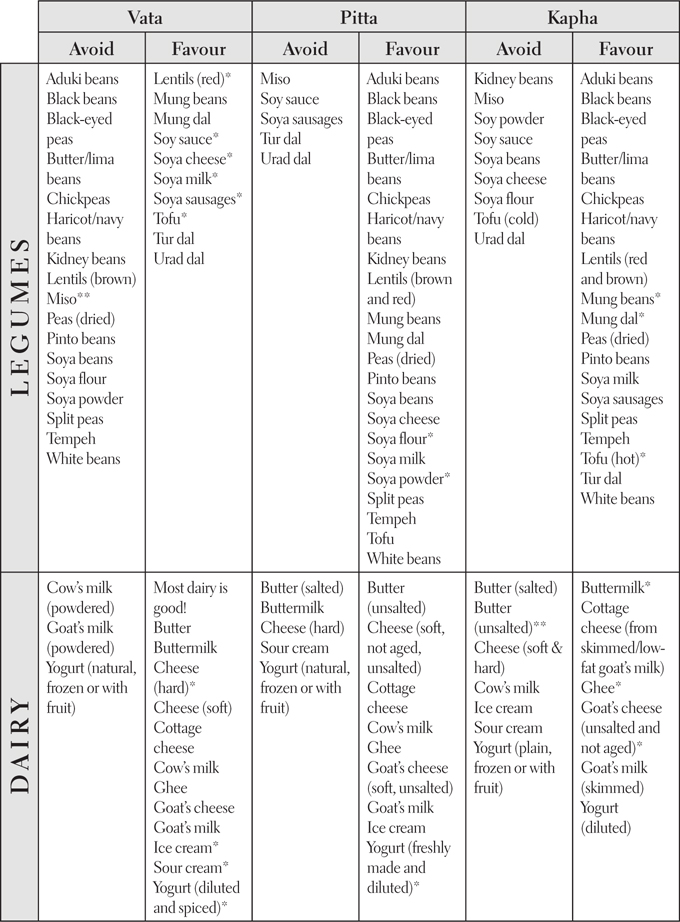
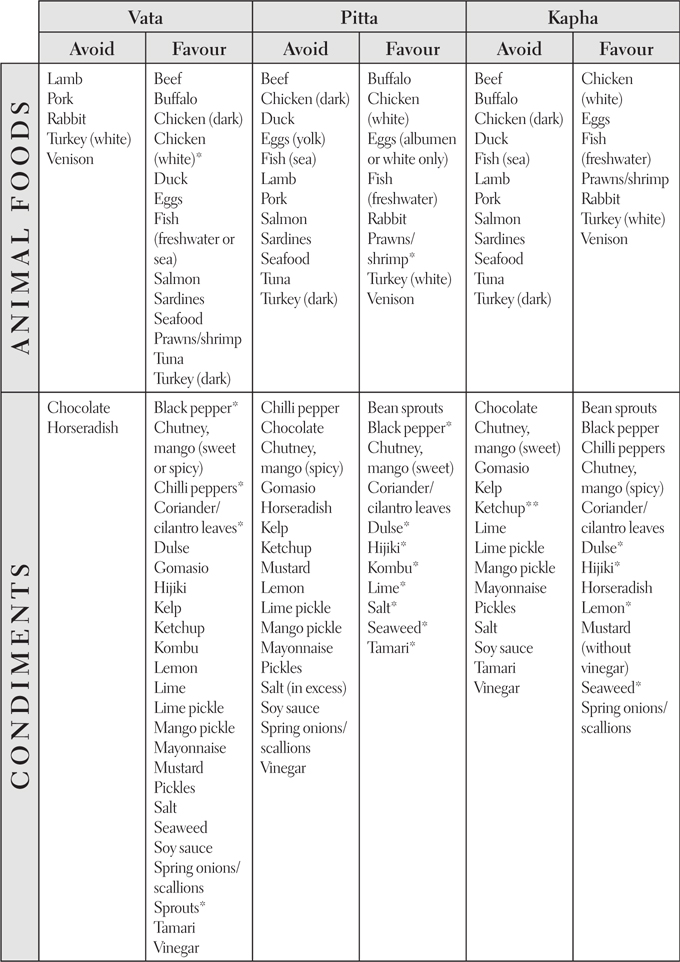
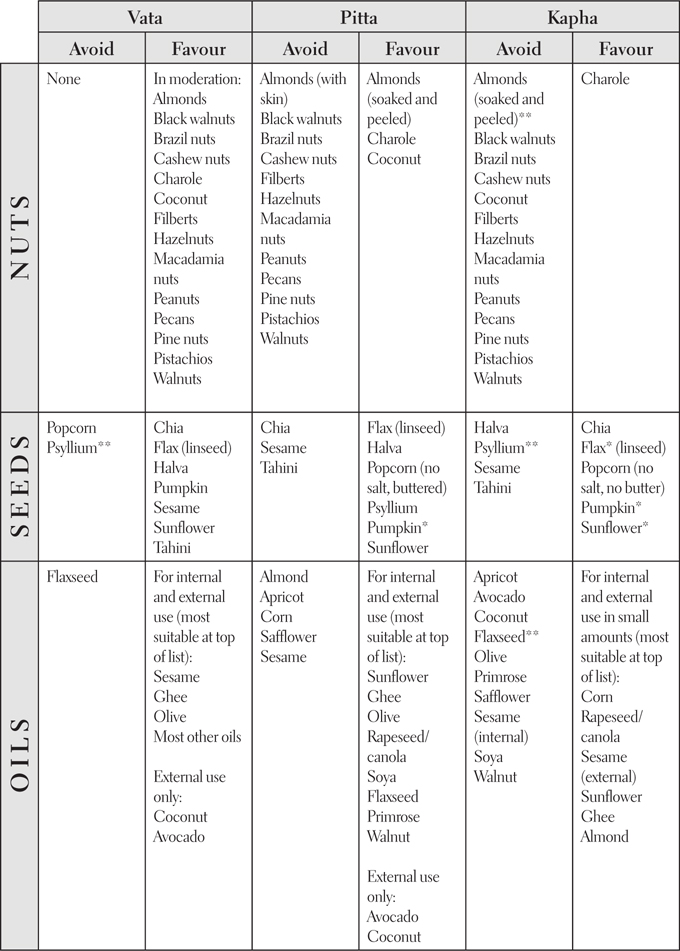
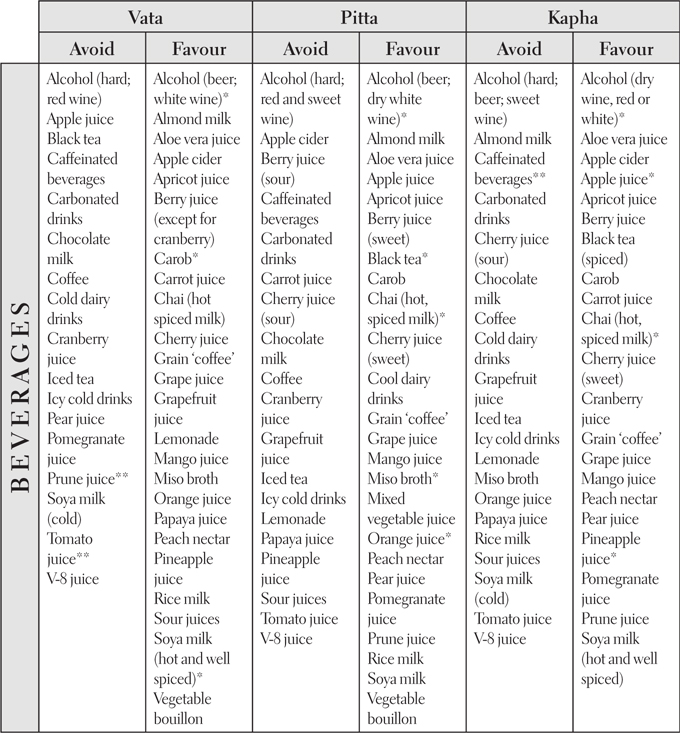
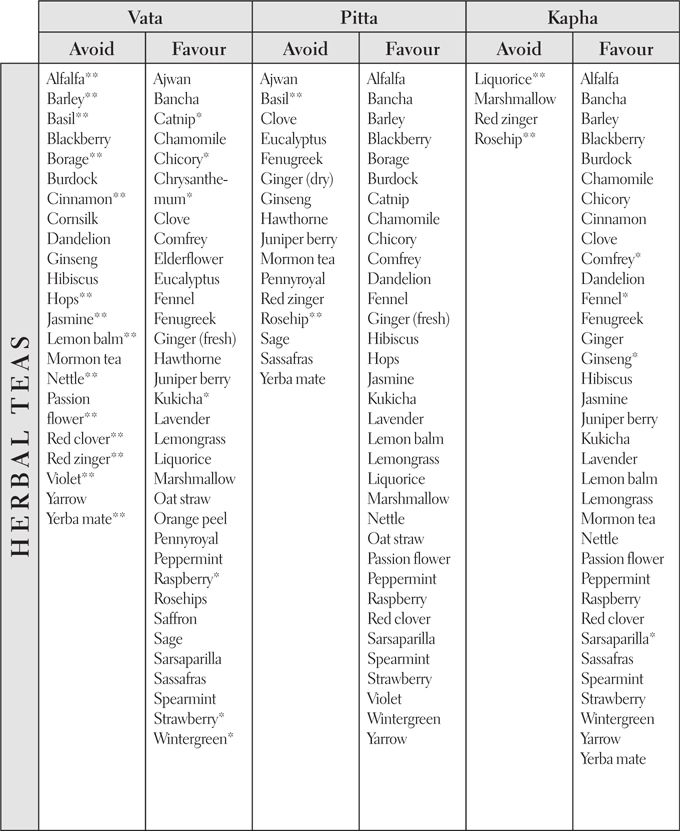

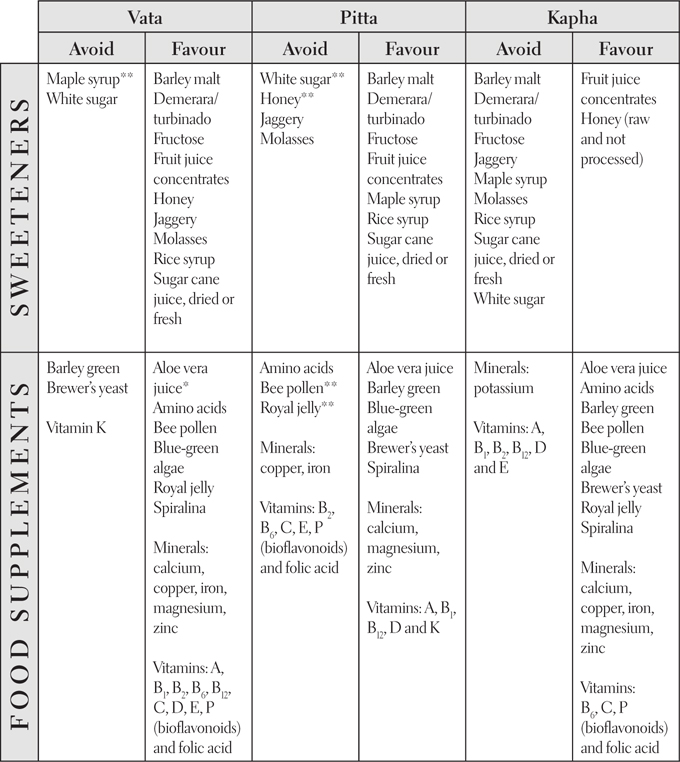
Copyright © Usha and Vasant Lad 1994